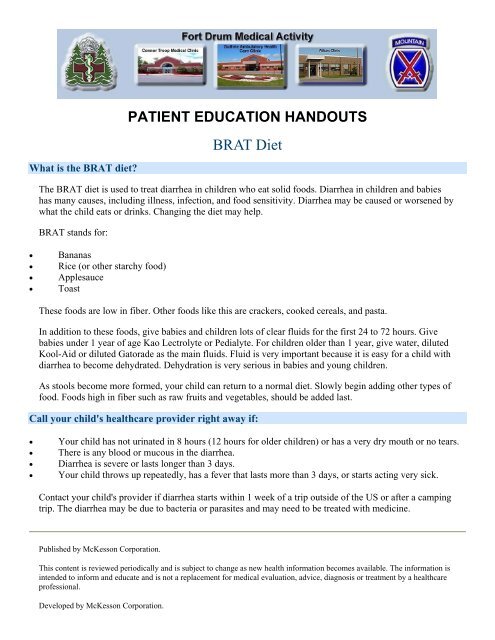BRAT Diet - US Army Medical Department Activity - Fort Drum
BRAT Diet - US Army Medical Department Activity - Fort Drum BRAT Diet - US Army Medical Department Activity - Fort Drum
What is the BRAT diet?PATIENT EDUCATION HANDOUTSBRAT DietThe BRAT diet is used to treat diarrhea in children who eat solid foods. Diarrhea in children and babieshas many causes, including illness, infection, and food sensitivity. Diarrhea may be caused or worsened bywhat the child eats or drinks. Changing the diet may help.BRAT stands for:• Bananas• Rice (or other starchy food)• Applesauce• ToastThese foods are low in fiber. Other foods like this are crackers, cooked cereals, and pasta.In addition to these foods, give babies and children lots of clear fluids for the first 24 to 72 hours. Givebabies under 1 year of age Kao Lectrolyte or Pedialyte. For children older than 1 year, give water, dilutedKool-Aid or diluted Gatorade as the main fluids. Fluid is very important because it is easy for a child withdiarrhea to become dehydrated. Dehydration is very serious in babies and young children.As stools become more formed, your child can return to a normal diet. Slowly begin adding other types offood. Foods high in fiber such as raw fruits and vegetables, should be added last.Call your child's healthcare provider right away if:• Your child has not urinated in 8 hours (12 hours for older children) or has a very dry mouth or no tears.• There is any blood or mucous in the diarrhea.• Diarrhea is severe or lasts longer than 3 days.• Your child throws up repeatedly, has a fever that lasts more than 3 days, or starts acting very sick.Contact your child's provider if diarrhea starts within 1 week of a trip outside of the US or after a campingtrip. The diarrhea may be due to bacteria or parasites and may need to be treated with medicine.Published by McKesson Corporation.This content is reviewed periodically and is subject to change as new health information becomes available. The information isintended to inform and educate and is not a replacement for medical evaluation, advice, diagnosis or treatment by a healthcareprofessional.Developed by McKesson Corporation.
What is the <strong>BRAT</strong> diet?PATIENT EDUCATION HANDOUTS<strong>BRAT</strong> <strong>Diet</strong>The <strong>BRAT</strong> diet is used to treat diarrhea in children who eat solid foods. Diarrhea in children and babieshas many causes, including illness, infection, and food sensitivity. Diarrhea may be caused or worsened bywhat the child eats or drinks. Changing the diet may help.<strong>BRAT</strong> stands for:• Bananas• Rice (or other starchy food)• Applesauce• ToastThese foods are low in fiber. Other foods like this are crackers, cooked cereals, and pasta.In addition to these foods, give babies and children lots of clear fluids for the first 24 to 72 hours. Givebabies under 1 year of age Kao Lectrolyte or Pedialyte. For children older than 1 year, give water, dilutedKool-Aid or diluted Gatorade as the main fluids. Fluid is very important because it is easy for a child withdiarrhea to become dehydrated. Dehydration is very serious in babies and young children.As stools become more formed, your child can return to a normal diet. Slowly begin adding other types offood. Foods high in fiber such as raw fruits and vegetables, should be added last.Call your child's healthcare provider right away if:• Your child has not urinated in 8 hours (12 hours for older children) or has a very dry mouth or no tears.• There is any blood or mucous in the diarrhea.• Diarrhea is severe or lasts longer than 3 days.• Your child throws up repeatedly, has a fever that lasts more than 3 days, or starts acting very sick.Contact your child's provider if diarrhea starts within 1 week of a trip outside of the <strong>US</strong> or after a campingtrip. The diarrhea may be due to bacteria or parasites and may need to be treated with medicine.Published by McKesson Corporation.This content is reviewed periodically and is subject to change as new health information becomes available. The information isintended to inform and educate and is not a replacement for medical evaluation, advice, diagnosis or treatment by a healthcareprofessional.Developed by McKesson Corporation.
Copyright © 2007 McKesson Corporation and/or one of its subsidiaries. All Rights Reserved.Copyright © Clinical Reference Systems 2008Pediatric Advisor_________________________________________________________________________________________________Reviewed 9 June 2008



